The BMAT is now sat on the 18th of October rather than the usual first week of November. The test has also changed to pen and paper. Early preparation is an absolute must!
Hi everyone!
This is part 2 of how to ace Section 1 of the BMAT. In part 1, we introduced the BMAT and covered the Critical Thinking questions, so in part 2 we’ll look at Problem Solving, and how the BMAT is scored and what it means for your application.
So let’s dive straight in!
Why Is Problem Solving Included?
Being a doctor is all about solving problems.
A patient comes to you with a variety of signs and symptoms, and from this limited information, it’s up to you to come to a diagnosis.
Whilst in the BMAT, they can’t get you to diagnose patients but they can test your ability to solve problems where the information isn’t all there and the approach to the problem is hidden.
Unlike Critical Thinking, there isn’t a question pattern that you can spot straight away.
The problems are much more varied, and so going in with an open mind is vital. Having said that, there are three styles of question they tend to ask:
An important thing to note is they’ve removed a question style.
Previously, you could get given a large block of text with some figures and be asked a set of questions on the data. Keep an eye out for this when you do past papers.
Since we covered why Section 1 is included in the BMAT and other basics in part 1, we’ll now go through some examples, and show you the tips and strategies to use.
Need some extra guidance in boosting your BMAT Problem Solving score?
Learn everything there is to know about the BMAT, with our BMAT Bundle and be guided by a tutor who scored in the top 10% – meaning you’re truly getting expert help.
Want to learn how to smash the BMAT, then this bundle is the one for you…


HOW LONG YOU HAD VS…
HOW LONG YOU’VE GOT.
Don’t leave yourself short on time! Get BMAT ready with the BMAT Bundle.
- 2 in 3 BMAT applicants used 6med support in 2021.


"Classic" Problem Solving Fully Worked Questions
Lets start with the “classic” Problem Solving questions you may face in the BMAT.
[1] "Classic" Problem Solving Worked Question
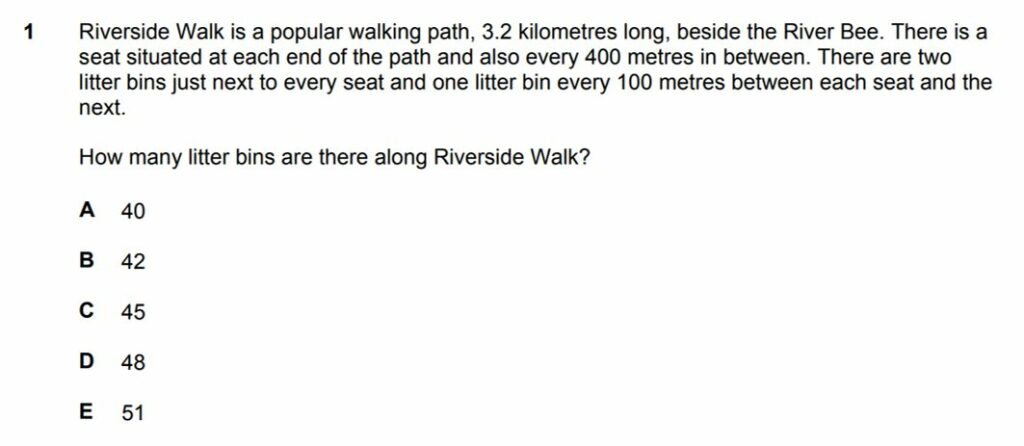
The biggest tip for Problem Solving is diagrams are your best friend!
The questions in the BMAT are written to be confusing, to hide the information you need, and to put everything in the wrong order that you need.
Trying to arrange all the information in your head, and solve the question is basically impossible and you’ll likely get into a muddle and use up your 100 seconds.
Make diagrams and arrange the information in a way you can use it. For example, a diagram for this question might look like this:
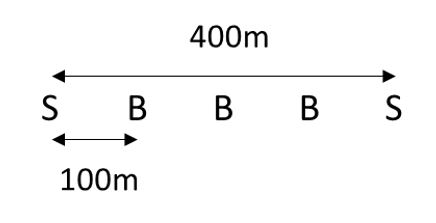
We are told that there are two bins by each seat, so starting from the seat at the start of the walk there are 5 bins in the 400m until the next seat. If the walk is 3.2km long, then there will be 8 lots of 5 bins, plus 2 bins for the seat at the end of the walk, giving a total of 42 bins.
You may be thinking “do I really need to draw a diagram of that, won’t it take too long and it seems a pretty straightforward question”, but the key to the BMAT is exam technique, more so than any exam you’ll have sat before.
The more you practise these questions, the quicker you’ll become at spotting the patterns they use and drawing suitable diagrams. If you just start by drawing a diagram, you won’t waste time deciding whether you need to draw a diagram.
[2] "Classic" Problem Solving Worked Question
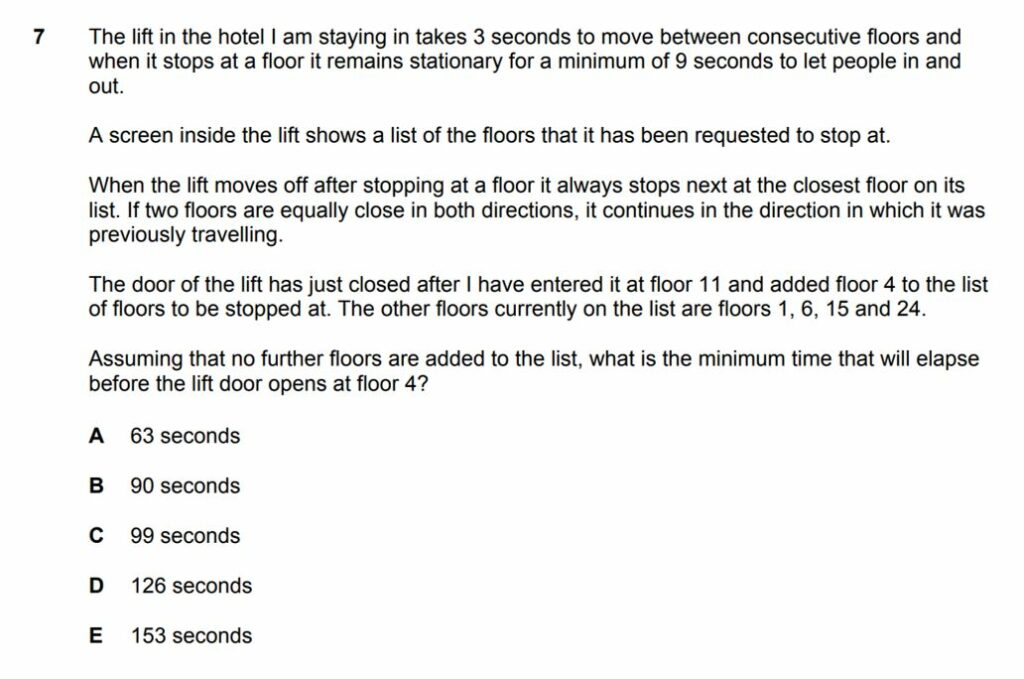
It’s for questions like this that drawing diagrams becomes essential. There’s a lot of information to take in here. The key bits to me are the floors on the list, the direction of travel and the time taken.
A good diagram looks like this:
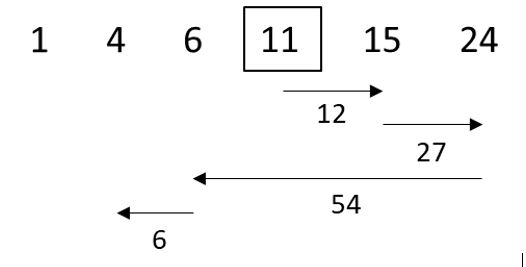
First, the floors have been written in order, so it becomes clear which way the lift will move.
Next, the travel times between floors have been added.
From floor 11, the lift is going to go first to floor 15, as it’s the closest floor.
From 15, floors 6 and 24 are both 9 floors away, however, the lift will continue up to 24 because it is in the direction the lift was previously travelling.
Then the lift will go down to 6, then to 4.
The question wants to know the total time elapsed to travel from floor 11 to floor 4. It takes 3 seconds to travel up or down one floor, so from floor 11 to floor 14 it will take 12 seconds. The lift will stop each floor for 9 seconds.
Totalling up all the time, we get 12 + 9 + 27 + 9 + 54 + 9 + 6 = 126 seconds
Tables And Graphs Fully Worked Questions
The next type of question that you’ll commonly see are questions that have tables and graphs.
Here’s a few worked examples of table and graph questions:
[1] Tables And Graphs Worked Question
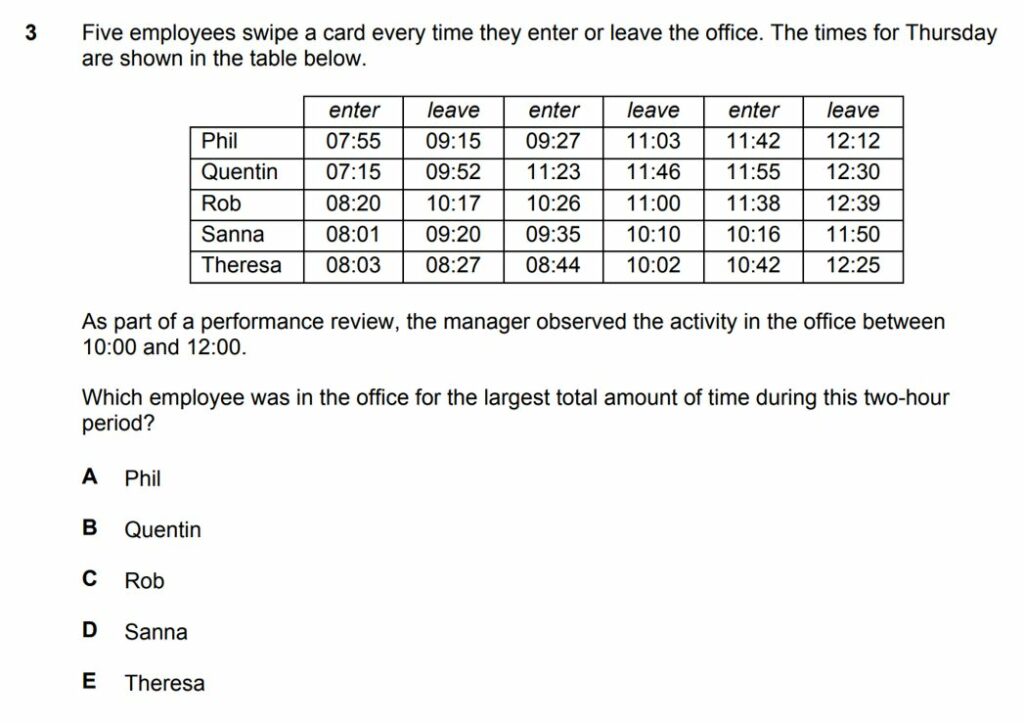
Starting with the table, the headings show 5 people and the times they enter and leave the office.
Draw a table showing the time each person was in the office between the hours of 10 and 12, and you’ll see Sanna is clearly ahead.
It’ll look something like this:
| In Office | Total | |
|---|---|---|
| Phil | 10 to 11.03, 11.42 to 12 | 81 |
| Quentin | 11.23 to 11.46, 11.55 to 12 | 28 |
| Rob | 10.26 to 11, 11.38 to 12 | 56 |
| Sanna | 10 to 10.10, 10.16 to 11.50 | 104 |
| Theresa | 10 to 10.02, 10.42 to 12 | 80 |
But an even quicker way would be to look at the time each person was not in the office.
Sanna is not in the office for just 16 minutes, and then working down the list you can see each person has a spell longer than 16 minutes out of the office, so without doing any calculations you can see Sanna is in the office the most.
This is another great trick as there’s often a shortcut you can use – the purpose of these questions is to test your ability to come up with novel calculations and solutions, so be aware that there’s often a better, less obvious way to do these questions.
[2] Tables And Graphs Worked Question
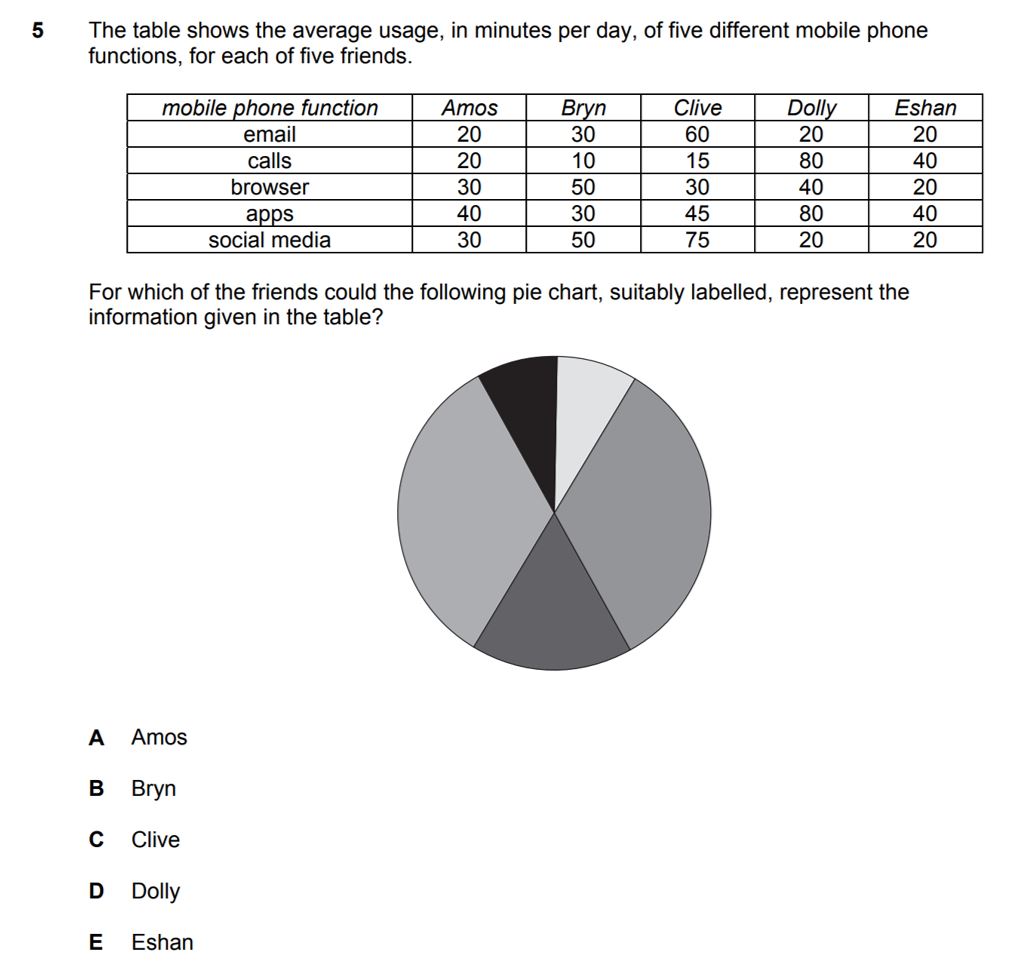
The key here is to not get bogged down reading all the data in the table.
Read the headings, to understand what data you’ve been given, and then read the question to find out what you need to know.
Here, the headings are mobile phone use, a list of people and time spent. The question wants you to pick the person whose mobile phone use matches the pie chart.
By eye, you can see the pie chart splits into 2 1/3rds, 1 1/6th and 2 1/12ths, so the minutes need to be 2 lots of x, 1 lot of 2x and 2 lots of 4x.
Going back to the table, Dolly would fit this (2 lots of 20, 1 lot of 40, 2 lots of 80).
[3] Tables And Graphs Worked Question
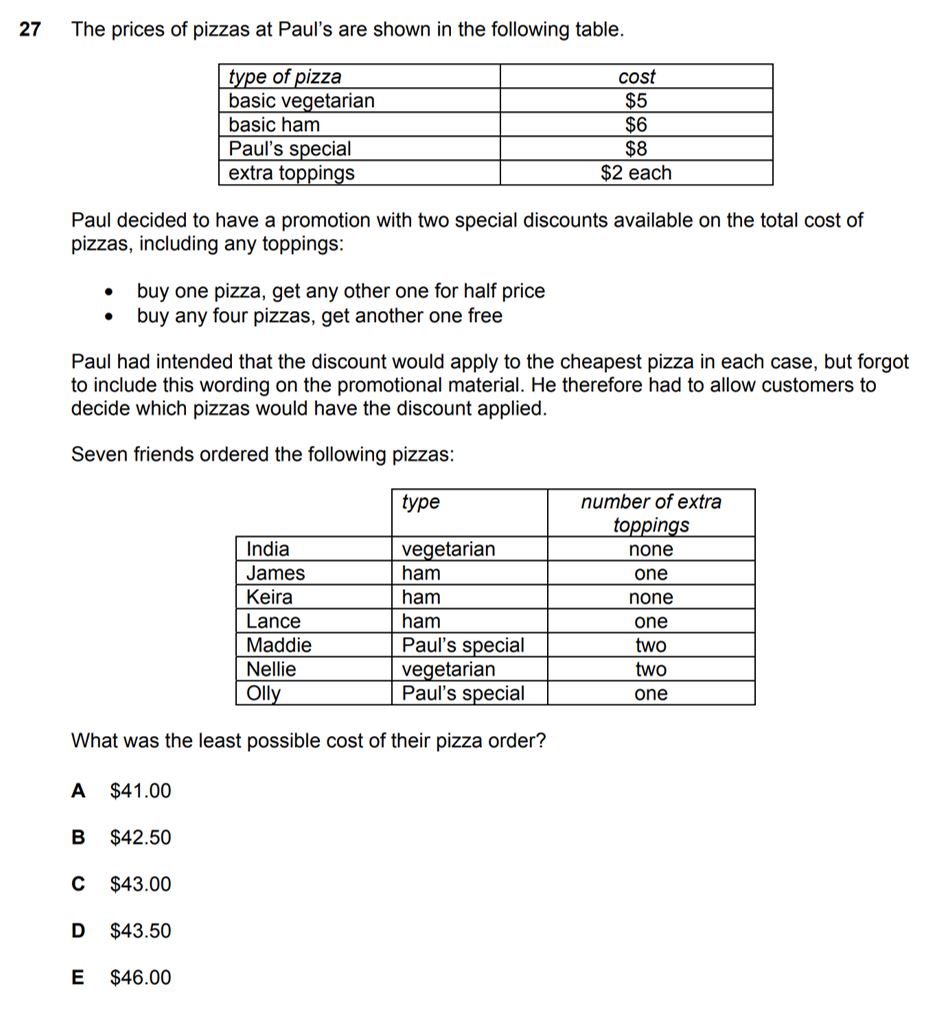
This is another question with a lot of information.
Skimming through highlighting the key points, we have the cost of pizzas, details of promotional discounts, a clarifying statement, and a pizza order.
The question asks for the cheapest possible cost of the pizza, so work backwards through the data.
Add another column to the table with the final cost of each pizza including toppings.
| Type | Extra Toppings | Cost |
|---|---|---|
| Vegetarian | None | $5 |
| Ham | One | $8 |
| Ham | None | $6 |
| Ham | One | $8 |
| Paul’s Special | Two | $12 |
| Vegetarian | Two | $9 |
| Paul’s Special | One | $10 |
There are 7 pizzas, so from the promotions, you can get 1 free and 1 half price.
There are no restrictions, so the best way to save money is to make the most expensive pizza free and the second most expensive pizza half price.
This means the final cost is $5 + $8 + $6 + $8 + $9 + $5 = $41.
We've got all the tips and tricks you need to score highly on the BMAT.
With our BMAT Bundle, cover Sections 1, 2 and 3 of the BMAT in detail with tips and strategies to ensure you achieve the highest possible score.
Want to learn how to smash the BMAT, then this bundle is the one for you…


HOW LONG YOU HAD VS…
HOW LONG YOU’VE GOT.
Don’t leave yourself short on time! Get BMAT ready with the BMAT Bundle.
- 2 in 3 BMAT applicants used 6med support in 2021.


Spatial Reasoning Fully Worked Question
In this section, we will cover a fully worked solution for a Spatial Reasoning question in BMAT Section 1.
A lot of students find spatial reasoning questions fall into two categories. Some you get straight away, and others you could spend hours staring at and get nowhere.
If it doesn’t come, remember you aren’t after full marks, so making the best guess is fine and more beneficial in the long run. If you can eliminate some options to increase your chances, that is even better.
[1] Spatial Reasoning Worked Question
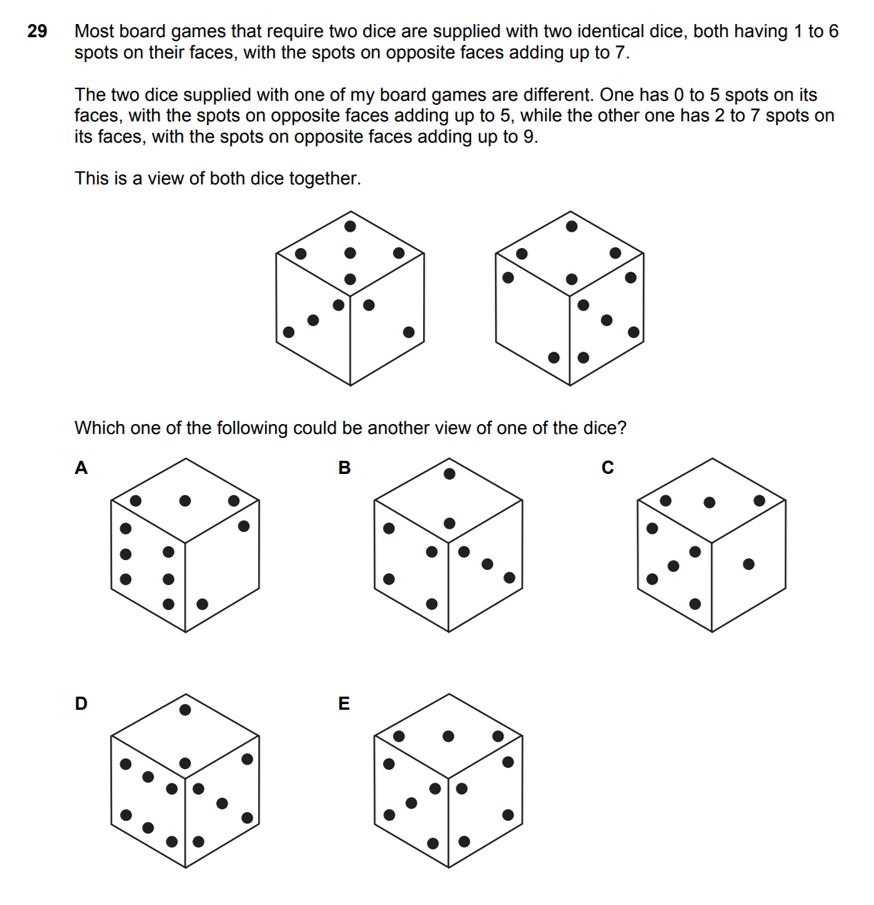
The first thing to do is work out what you’re looking at, and which dice is which.
- We are told that on one dice the faces add to 5 and on the other, the faces add to 9.
- We can see 3 and 2 are not opposite each other on the left dice, so that must be the one adding to 9
- Likewise, we can see 5 and 4 are not opposite each other on the right dice so that must be the one adding to 5.
Now we can work through the options, first working out which dice it is and then whether it’s a possible view.
A and B both have the same arrangement of 3 and 2, so are the 9 dice.
We can also immediately eliminate them as options because we know that the 3 and 2 make an arrow towards 5.
C must be the 5 dice, as it has a 1. This view does match up with the dice, so C is the correct answer.
D must be the 9 dice and is incorrect as the 6 should be a 3. E must be the 5 dice and is incorrect because the 3 should be a 2.
Another trick you could use here is to draw out nets.
It’s really common for them to give you cubes or tetrahedrons to interpret, so if you can quickly draw out a net that can really help you visualise the problem.
You might feel silly ripping up a piece of paper in the exam, but nothing is stopping you and if it means you get that extra mark it’s definitely worth it!
BMAT Section 1 Scoring
Section 1 of the BMAT is out of 32 raw marks, which are then converted into a score from 1 to 9. How they work out the conversion isn’t revealed.
Have a look at the results from 2020:
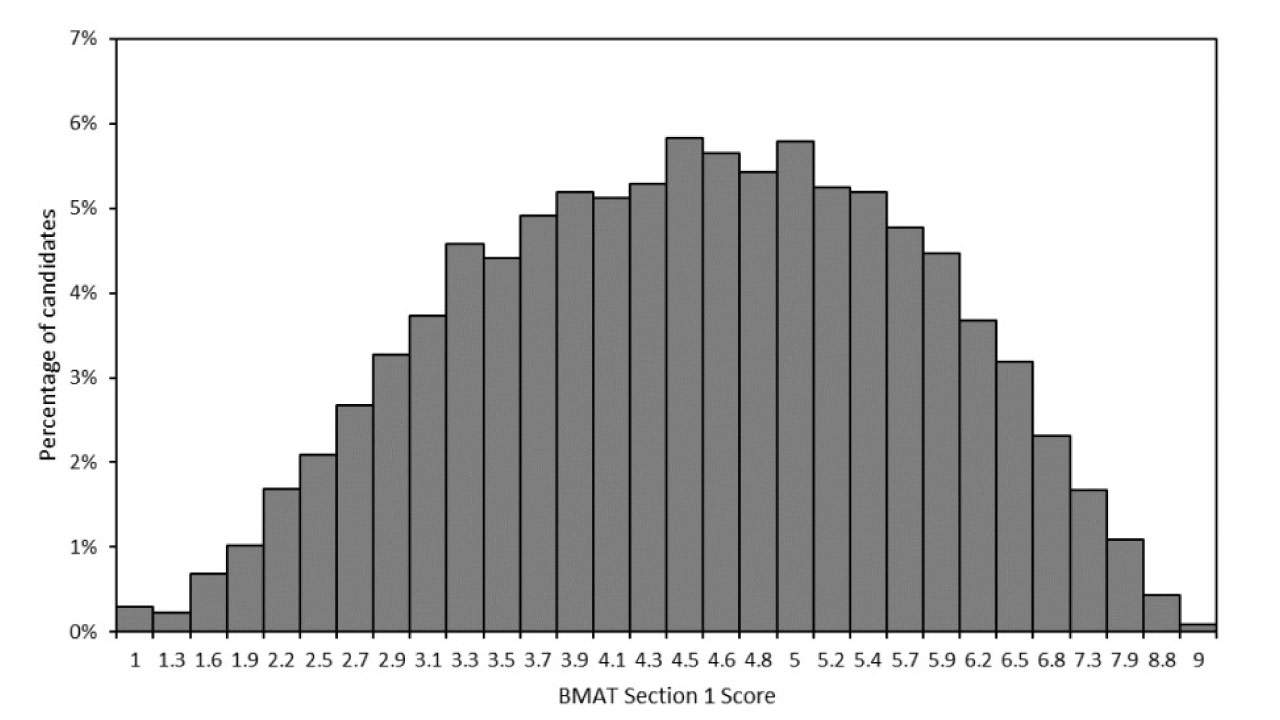
In Section 1, 25% of test-takers scored between 5.0 and 6.1 and 10% of applicants scored over 6.2. Extreme scores are rare.
You don’t have to get that many more marks than the average of around 4.5-5.0 to put you up in a high decile to really stand out – and full marks are definitely not required!
Putting a little bit of time into researching and understanding how universities use your BMAT score can really help improve your chances.
Some universities use the BMAT as a screening tool. Medical schools have to whittle down a lot of very good, very similar applications, and as we’ve seen above, the BMAT is a way to differentiate applicants. Medical Schools might decide on a minimum BMAT score of 5.0, and that way they are immediately left with the top 25% of applicants to go through Personal Statements and interviews.
Other universities take a holistic picture and will look at the BMAT scores in combination with everything else. For instance, UCL use BMAT scores alongside UCAS applications. They do not have a cut-off score but high scores in each section will strengthen an application. UCL also use Section 3 essays for discussion in interviews.
Be proactive and get hold of this information, at open days or by emailing or phoning university admission offices.
Then you can use this to plan your application.
If you think you’ll do well at the BMAT, consider universities that use it as a screening tool. Likewise, if it’s maybe not a strength for you, don’t waste a choice on a university where you’ll be ditched before they’ve looked at anything else in your application. Pick universities that place more weight on other parts of the application.
Our Closing Tips
Here are the main take-home messages for Problem Solving:
1
Do lots of practice under exam conditions. Check out our popular Online BMAT Question Bank to practise under exam conditions.
2
Draw as many diagrams as you can.
3
The best way to solve a question may not be immediately obvious, keep an open mind when you’re reading the question.
4
You don’t have a calculator, so look out for numbers that multiply or divide easily, often that’s a hint you need to use them.
5
For questions with graphs and tables start with the headings.
6
Cubes and tetrahedrons come up all the time for spatial reasoning.
7
To do really well at the BMAT you don’t need full marks, play the game and you’ll do fine!
Well done for reaching the end! Hopefully you’ve gotten something from these articles about how to approach Section 1.
Take what you’ve learnt and just practise, practise, practise, and you’ll be in a great place to ace the BMAT!
Need some extra guidance in boosting your BMAT Problem Solving score?
Learn everything there is to know about the BMAT, with our BMAT Bundle and be guided by a tutor who scored in the top 10% – meaning you’re truly getting expert help.
Want to learn how to smash the BMAT, then this bundle is the one for you…


HOW LONG YOU HAD VS…
HOW LONG YOU’VE GOT.
Don’t leave yourself short on time! Get BMAT ready with the BMAT Bundle.
- 2 in 3 BMAT applicants used 6med support in 2021.

